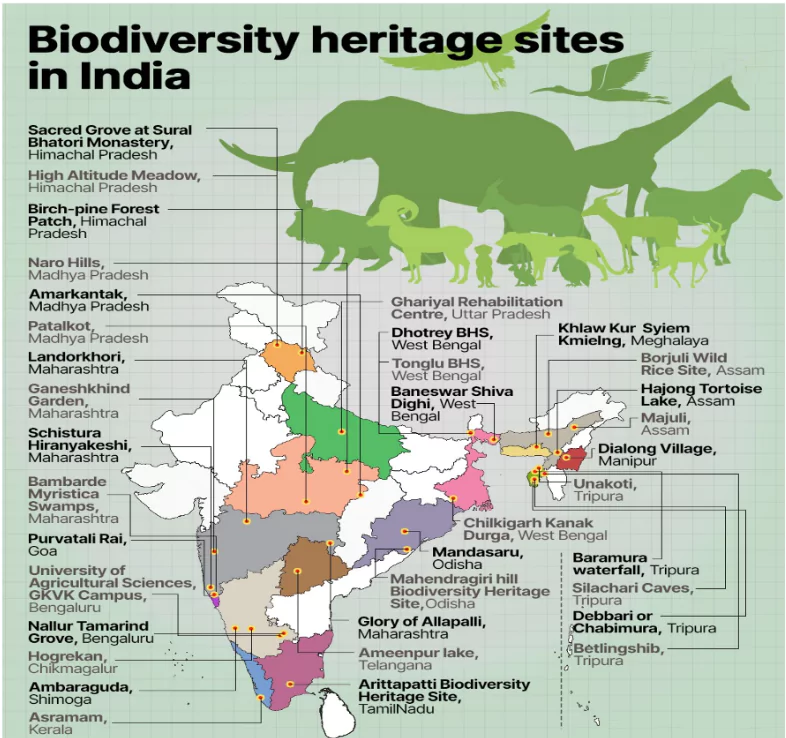The Union government granted permission for tungsten mining in Arittapatti, Madurai, Tamil Nadu.

About Arittapatti
- Biodiversity Heritage Site: Tamil Nadu’s first & India’s 35th Biodiversity Heritage Site.
- Ecological Significance:
- Houses 250 bird species, including Laggar Falcon, Shaheen Falcon, and Bonelli’s Eagle.
- Home to Indian Pangolin, Slender Loris, and Pythons.
- Surrounded by seven hillocks (inselbergs) & three check dams.
- Historical Significance:
- Includes the Anaikondan Lake, constructed during the 16th-century Pandiyan reign.
- Rich in cultural heritage, featuring megalithic structures, rock-cut temples, Tamil Brahmi inscriptions, and Jain beds.
About Biodiversity Heritage Site (BHS)
- BHS are ecosystems of high biodiversity significance, comprising of any one or more of the following components:
- Richness of wild as well as domesticated species or intra-specific categories.
- High endemism.
- Presence of rare and threatened species, keystone species, species of evolutionary significance.
- Wild ancestors of domestic/cultivated species or their varieties.
- Past pre-eminence of biological components represented by fossil beds and having significant cultural, ethical or aesthetic values and are important for the maintenance of cultural diversity, with or without a long history of human association with them.
- Legal Framework:
Enroll now for UPSC Online Course
Biodiversity Heritage Site (BHS) in India
- First BHS in India:
- Nallur Tamarind Grove, Bengaluru, Karnataka, declared in 2007.
- Latest Addition:
- Haldir Char Island and Birampur-Baguran Jalpai in West Bengal (2023)
- Tungkyong Dho in Sikkim (2023)
- Gandhamardan Hill (2023) and Gupteswar Forest in Odisha (2024)
|
-
- Governed under Section 37(1) of the Biological Diversity Act, 2002.
- State Governments, in consultation with local bodies, can notify areas of biodiversity importance.
- Community Role:
- Establishing BHS does not restrict local practices unless voluntarily adopted by the community.
- The initiative aims to enhance local livelihoods while promoting conservation.
About Tungsten
- Tungsten, also known as Wolfram, is a dense metal that appears greyish-white to steel-grey. It is listed as one of India’s 30 Critical Minerals due to its strategic importance.
- Key Properties: Tungsten has unique physical and chemical attributes:
- It possesses the highest melting point among metals, at 3,422°C.
- The metal exhibits high tensile strength, elasticity, and corrosion resistance.
- Its excellent thermal and electrical conductivity, combined with a low expansion coefficient, makes it versatile for industrial applications.
Check Out UPSC Modules From PW Store
- Applications: Tungsten is used in various fields, including:
- Lighting: Manufacturing filaments for light bulbs and vacuum tubes.
- Heating Systems: As heating elements in electrical furnaces.
- Steel Alloys: Enhancing hardness and durability in specialized steel products.
- Reserves and Distribution in India: India’s total tungsten ore reserves are estimated at 89.43 million tonnes, containing approximately 1,44,650 tonnes of WO₃.
- Karnataka holds the largest share of reserves (41%), followed by Rajasthan (27%), Andhra Pradesh (17%), and Maharashtra (11%).
- Smaller deposits are also found in Haryana, Tamil Nadu, Uttarakhand, and West Bengal.
![]() 22 Nov 2024
22 Nov 2024


